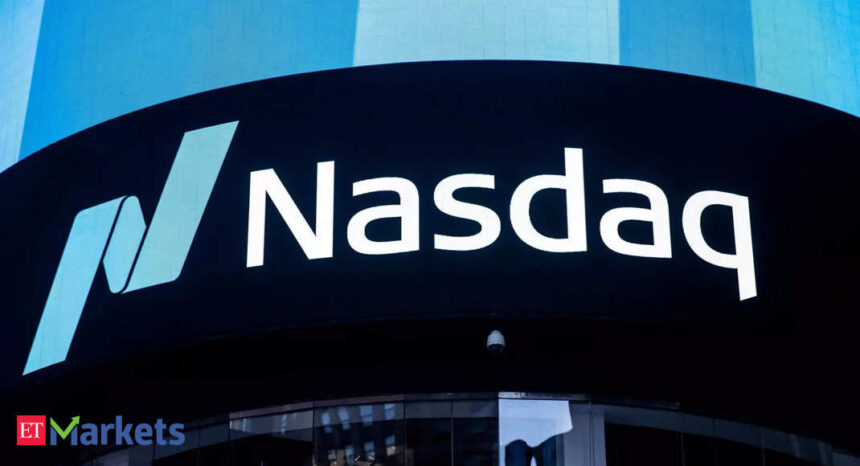Individually, none of these bearish prophecies have slowed a market rally that has added $5 trillion to the Nasdaq 100’s value since December. But when they start exerting fresh pressure all at once, even the boldest proponents of artificial intelligence can be forgiven for feeling sheepish.
Such was the case this week. China’s expansion of a ban on Apple Inc.’s iPhone landed just as bond yields nudged higher, underlining a market-valuation picture that some see an outright bubble. Coming off its best week since June, the Nasdaq slumped, with Apple and rally champion Nvidia Corp. both notching their second-worst falls of the year.
The burden faced by investors inclined to take a flyer on software and internet stocks is clear when looking at the headline fundamentals. Nasdaq 100 equities trade at 27 times annual earnings, 35% above the S&P 500 — whose own valuation is inflated by the same tech megacaps. Versus sales, the Nasdaq fetches a multiple of nearly five, almost twice as expensive as the broader market.
 Bloomberg
Bloomberg“There is a lot of faith that the prospects for AI are real and will not end up the same way that the internet bubble stocks did,” said Peter van Dooijeweert at Man Solutions. “Even modest news flow has led to larger moves to the downside in several specific technology stocks suggesting vulnerability may be more than perceived.”Numbers like that informed the week’s loudest warning — a study by factor-investing legend Rob Arnott that labeled Nvidia “a great company priced beyond perfection.” The whole market is a potential casualty, said the founder of Research Affiliates LLC, when investors wake up to his view that the AI powerhouse isn’t “too big to fail,” but “too big to succeed.”
Take a look at the big five platforms — Apple, Amazon.com Inc, Meta Platforms Inc., Alphabet Inc and Microsoft Corp. — which have fast evolved into “mature companies” whose massive revenues barely keep up with nominal gross domestic product growth, wrote Vincent Deluard, director of global macro at StoneX Financial. “Their collective net income fell to $263 billion in the past four quarters, down 9% from $289 billion the year before,” he said. “If stock prices are the net present value of their future cash flows, higher rates should penalize growth stocks, which derive most of their profits from distant profits.”
 Bloomberg
Bloomberg
How the group became so richly priced is an oft-told and uncomplicated story. Companies like Microsoft and Meta command higher valuations because their business models are relatively immune to the business cycle and offer attractive long-term prospects.A nagging rebuttal to that view has been the trajectory of interest rates, whose rise draws money away from risk assets and, theoretically, reduces the value of future cash flows. And while this week’s increase in 10-year yields wasn’t huge — about seven basis points — these kind of levels are the highest in more than two decades.
“Tech valuations are clearly stretched. Tech and AI do have the potential to make important, transformational changes to the global economy, but time horizon expectations for these productivity boosts are far too short,” said Seema Shah, chief global strategist at Principal Asset Management. “They deserve a place in portfolios, it’s just that today may not be the best time to be adding exposure.”
Investors have become so optimistic about the AI future that not even surging bond yields have stopped the outperformance over tech shares. But that tailwind might be starting to fade. While analysts have been upgrading earnings estimates for growth stocks more than for value lately, that gap has started to narrow, Lori Calvasina, head of US equity strategy at RBC Capital Markets, wrote in a note this week.
Another argument, proffered by strategists at Sanford C. Bernstein, is that while bond yields have risen this year, broader gauges of financial conditions that encompass the dollar and corporate bond spreads have actually eased.
“If the market’s assessment of the economic outlook worsens, and financial conditions tighten as a result, tactically Growth is likely to under-perform, if the current relationship remains in place,” the team led by Sarah McCarthy wrote in a note.
Still, if growth stocks have ridden American economic resilience to perfection, that optimism has been far from widespread.
The narrowing leadership is a “bad omen,” says Capital Economics, citing instances in 1990, 2007 and 2011 when the S&P 500 outperformance was driven by only a select few. Each case was followed by or coincided with a big fall in the benchmark index, though there have also been instances when the concentration persisted for much longer, says the firm’s chief markets economist, John Higgins.
For another illustration of the problem, the lopsided gains in the priciest name have now widened their premium over the cheapest back near levels seen in 2020 — which preceded the epic comedown for mega-cap tech over the last two years.
 Bloomberg
Bloomberg
For all the AI magic of Big Tech, it might still come down to investor positioning. One in five large-cap active funds now has more than 40% of their assets in the so-called Magnificent Seven mega-caps, compared with 12% last year, according to second-quarter filings compiled by Bank of America Corp.
“Equity market valuations definitively remain high compared to most periods in history, which is surprising given the current level of rates,” said Man’s van Dooijeweert. “As quantitative tightening continues, equities will continue to be challenged whenever we see rates move higher.”








